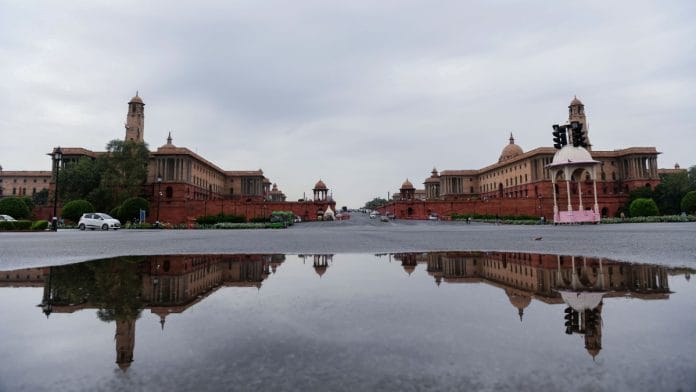New Delhi: Having received a go-ahead from the Heritage Conservation Committee (HCC), the Central Public Works Department (CPWD) is set to start restoration of North Block to its original design next year to accommodate the proposed Yuge Yugeen Bharat Museum, ThePrint has learnt from housing ministry officials.
The museum, set to be the world’s largest, will come up in the North and South blocks as part of the Central Vista Redevelopment Project.
Last month, the HCC approved the CPWD’s proposal for “restoration and comprehensive repair” of North Block, a Grade-I heritage building constructed in the 1930s that houses vital ministries such as home affairs and finance. ‘Grade-I’ comprises buildings and precincts of national or historic importance.
While no major structural changes have been made to the heritage building, partitions were created inside it in accordance with requirements of various ministries.
Approving the proposal in a meeting on 24 October, the HCC directed the CPWD to maintain the originality of the heritage building. It stated that the repair/restorations should be done “in such a way to maintain originality of existing heritage building in terms of character, construction, colour, form, materials etc. and no external intervention is allowed including heat resistant paint on the terrace”, according to the minutes of the meeting.
According to senior officials of the Ministry of Housing and Urban Affairs (MoHUA), the School of Planning and Architecture, Bhopal, has carried out a survey of the heritage building, mapping all the changes made to it post-Independence, and submitted a restoration plan.
“SPA-Bhopal has submitted the restoration plan after a detailed survey of the building and referring to the original drawings, the construction methodology etc. The plan is to restore the building to its original format by removing all the additions that were made to it post-Independence,” said a senior ministry official aware of the development. “There were utilities that were added to the buildings to meet modern-day requirements, which now have to be removed. The building will be brought back to its original shape and then repurposed to be a museum.”
A second ministry official added that the restoration work will start mid-next year after the ministries shift to the new Common Central Secretariat (CCS) buildings, a part of the Modi government’s ambitious Central Vista project. The first set of three CCS buildings—out of a total 10—are proposed, as part of the project, to house 51 ministries and departments. These are expected to be ready by January-end.
Also Read: Plan changes & lack of clarity, what’s causing delays in Delhi’s Central Vista revamp project
Interventions proposed to ensure structural stability
SPA-Bhopal is working on a detailed plan for implementation of the restoration work, based on which the CPWD will invite bids, according to a senior ministry official.
In its proposal, the CPWD has said necessary interventions will be carried out as part of the restoration work “to prolong” the North Block’s “lifespan”, prevent “damage and deterioration”.
The aim is to “…prevent damage and deterioration; minimise the impact of external agents of decay and intervention on the building and its material and prepare for natural and human induced disasters,” the proposal said, according to the minutes of the 24 October meeting.
A professor at SPA-Bhopal said, “Over the years, a lot of modifications have happened and services such as air-conditioning facilities have been added to meet present-day requirements. We have done the assessment work and are in the process of preparing detailed plans to restore the building to as close to its original condition.”
The professor added, “As the building is almost 100 years old, we have looked at the structural stability of the building. We have taken all the technical details, material strength and how much it has deteriorated over a period of time.”
Urban design expert K. T. Ravindran, former chairman of the Delhi Urban Art Commission, said, “The integrity of the original material and structure must be retained while carrying out restoration work. If sandstone was used, then no other material should be used instead of it.”
He added that one of the main challenges in restoration work is to ensure the structural stability of the building. “Structure stability is an issue as most of the colonial buildings have been constructed without introducing any steel into them; they are compression-based structures. These buildings attain their strength from their own self, from their own weight.”
(Edited by Gitanjali Das)
Also Read: Central Vista museum committee ‘met only once’ since 2022. No clarity on artefacts’ destination






